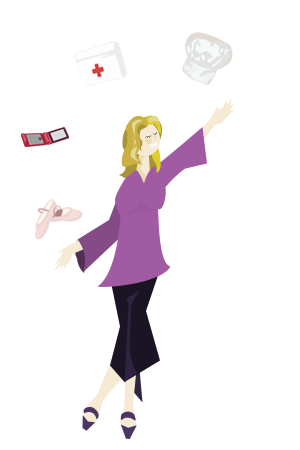It took me about a year and half to actually finish writing my 40×40 list. I wouldn’t stoop to the hubby’s level and cheat (#1. Put 40 items on my 40×40 list.), though. As I got more involved in working towards my goals, I found that the subject came up a lot with my friends, especially MFJ. During one GNO, we window shopped at a mall and saw the cutest shoes. With heels. I commented that I could never wear them because I can’t walk in heels. She stopped in her tracks and told me I absolutely had to learn and she could help. It became #40 on the list.
Enter BlogHer. The one and only professional conference that’s all about the shoes. When celebrity guests include Tim Gunn and Carson Kressley, fashion is definitely at the forefront. MFJ informed me that I would absolutely be wearing heels with my pretty dresses for the BlogHer cocktail parties. She was determined to teach me.
After a week of walking around the house on my tippy toes, we planned one of our infamous girls’ night in. It happened to be National Pina Colada Day so, naturally, that was our beverage of choice. We began with dinner, then moved onto pina coladas (including virgins for the littles). After the pineapple-coconut slushies were consumed, we sent the girls upstairs for their sleepover portion of the evening. After a few quick lessons, I was suddenly circling the house in heels (gotta love an open floor plan). We spent another hour or so walking and talking (and, okay, drinking pina coladas) before she deemed me sufficiently able to walk in heels and we collapsed on the couch.
Yet, I didn’t cross it off the list. I wanted to prove that I could actually wear them regularly. And, let’s face it, I want to be able to graduate to some serious stripper heels. Otherwise, what’s really the point? I wore casual, baby heels during the day at BlogHer, then donned my shiny new black heels each evening when I got to wear the pretty, pretty cocktail dresses. I survived the weekend rather well, I think, but I still didn’t cross it off the list. A few hours each evening just didn’t have me convinced. For BlogIndiana, I rocked the heels all day long.
That should have been good enough. I never tripped, never toppled and never kicked them off (as that would have meant losing their power). I should have stopped there. There really was no need to cavort around downtown Indy, amidst the freaks and geeks. Oh, yeah—stormtroopers! Who spends GenCon weekend in downtown Indy and doesn’t get to see stormtroopers? Not me! It was an absolutely fabulous time hanging with people I adore, great bloggers I’d never met in real life and all new friends, documented much more efficiently by fabulous people who are not me.
All while crossing an item off the list. I have officially learned to walk in heels. And I have the blisters to prove it.








